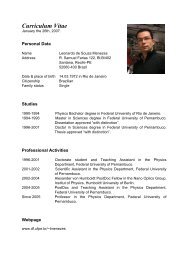Download Abstracts Book - DF-UFPE Pessoal
Download Abstracts Book - DF-UFPE Pessoal
Download Abstracts Book - DF-UFPE Pessoal
You also want an ePaper? Increase the reach of your titles
YUMPU automatically turns print PDFs into web optimized ePapers that Google loves.
Synthesis and Characterization of KMo 4 O 6<br />
M. Andrade, M. L. Maffei, L. M. S. Alves, C. A. M dos Santos, B. Ferreira and A. F. Sartori.<br />
Escola de Engenharia de Lorena – USP, P. O. Box 116, Lorena, SP 12602-810, Brazil<br />
ma@ppgem.eel.usp.br<br />
The KMo 4 O 6 compound is an important molybdate that shows interesting physical<br />
properties such as high anisotropy, structure with infinites chains with Mo 6 octahedra,<br />
metal–insulator transition (MIT) near 120 K, and quasi-one-dimensional electrical<br />
behavior [1]. This compound crystallizes into two phases. One has tetragonal structure<br />
with space group P4/mbm, lattice parameters a = 9.612 Å and, c = 2.950 Å. The<br />
synthesis of KMo 4 O 6 is commonly carried out by electrolysis of molten salts [2, 3]. One<br />
the biggest issue in studying high anisotropic conductors and MIT is due to these<br />
behaviors appear closed related to the superconductivity [4].<br />
The crystals grew in the form of black square prisms with dimensions of 1.0 x<br />
0.2 x 0.2 mm³. They were obtained from a mixture of K 2 MoO 4 and MoO 3 in the molar<br />
ratio of 6:1, dried at 160 ° C and 450 ° C. The synthesis occurred with a current of 20 –<br />
25 mA at 930 °C for 52 h. X- ray diffractometry confirmed that the crystals obtained<br />
were due to the KMo 4 O 6 phase with the same characteristics reported previously [2,3].<br />
Electrical resistances measurements were done by standard four-probe method using a<br />
PPMS from 2 to 300 K. The results show metallic behavior with a MIT near 120 K.<br />
Magnetic measurements were done parallel and perpendicular to the field in the range 2<br />
– 300 K using a VSM coupled in a PPMS. The MxT curves agree with the magnetic<br />
anisotropy reported previously. MxH curves display non-linear behavior at high<br />
temperatures which suggest that the KMo 4 O 6 compound does not show a Pauli<br />
paramagnetism as reported previously. The results also suggest magnetic ordering<br />
which happens near the metal–insulator transition temperature.<br />
Acknowledgement: FAPESP (2010/06637-2 and 2009/54001-2), CNPq (490182/2009-<br />
7 and 309084/2010-5) and CAPES.<br />
[1] K. V. Ramanujachary, M. Greenblatt, E. B. Jones and, W. H. M. C. Carroll, J. Solid<br />
State Chem. 102, 69 (1993).<br />
[2] W.H. McCarroll, K. V. Ramanujachary, M. Greenblatt and, Richard E. Marsh, J.<br />
Solid State Chem. 117, 217 (1995).<br />
[3] R. Hoffman, R. Hoppe, K. Bauer, and K. J. Range, J. Less Common Met.161, 279<br />
(1990).<br />
[4] C. A. M. dos Santos, B. D. White, Yi-Kuo Yu, J. J. Neumeier, and J. A. Souza,<br />
Physical Review Letters 98, 266405 (2007).<br />
91






